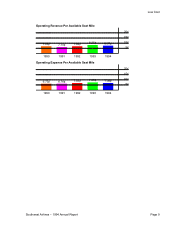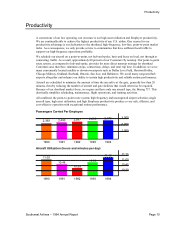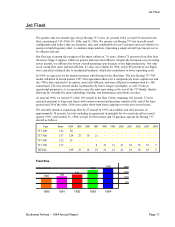Southwest Airlines 1994 Annual Report Download - page 19
Download and view the complete annual report
Please find page 19 of the 1994 Southwest Airlines annual report below. You can navigate through the pages in the report by either clicking on the pages listed below, or by using the keyword search tool below to find specific information within the annual report.Management's Discussion and Analysis of Financial Condition and Results of Operations
Southwest Airlines – 1994 Annual Report Page 19
Salaries, wages, and benefits per ASM increased only .5 percent in 1994. This increase resulted from a 3.0
percent increase inaverage salary and benefits cost per Employee, partially offset by slower average
headcount growth, which increased only 13.8 percent in 1994 versus the 1994 capacity (ASM) increase of
16.8 percent. The majority of the increase in average salary and benefits cost related to increased health
benefits and workers' compensation costs. Employee productivity improved from 2,633 passengers
handled per Employee in 1993 to 2,676 in 1994.
Profitsharing and Employee savings plan expenses per ASM increased 4.8 percent in 1994. The increase
is primarily the result of increased matching contributions to Employee savings plans resulting from
increased Employee participation and higher matching rates in 1994 for Flight Attendants and Customer
Service Employees under their respective collective bargaining agreements.
Fuel and oil expenses per ASM decreased 9.9 percent in 1994, primarily due to an 8.8 percent reduction
in the average jet fuel cost per gallon from 1993. Jet fuel prices remained relatively stable throughout
1994, with quarterly averages ranging from $0.51 to $0.56 per gallon. Since year-end, fuel prices have
averaged approximately $0.54 per gallon.
In August 1993, the Revenue Reconciliation Act of 1993 was enacted, which, among other things,
included an increase of 4.3 cents per gallon in transportation fuel tax, which becomes effective September
30, 1995, for jet fuel used in commercial aviation. This additional fuel tax will increase fuel expenses
approximately $7.5 million in fourth quarter 1995.
Maintenance materials and repairs per ASM was unchanged in 1994 compared to 1993.
Agency commissions per ASM decreased 11.3 percent due to a lower mix of travel agency sales and lower
1994 passenger revenue per ASM. The lower travel agency sales mix resulted from 1994 enhancements to
Southwest's ticket delivery systems for direct Customers, as described below.
In response to actions taken by our competitor-owned reservations systems, we reduced our operating costs
and enhanced our ticket delivery systems by developing our own Southwest Airlines Air Travel
(“SWAT”) system allowing high-volume travel agents direct access to reservations; introduced overnight
ticket delivery for travel agents; reduced to three the number of advance days reservations required for
overnight delivery of tickets to customers (Ticket By Mail); developed our own Ticketless system, which
was rolled out system-wide on January 31, 1995; and subscribed to a new level of service with SABRE
that will automate the booking process for SABRE travel agencies effective May 1, 1995. We also
continue to actively pursue other cost-effective solutions for automating non-SABRE travel agency
bookings.
Aircraft rentals per ASM increased 7.7 percent in 1994. The increase primarily resulted from a third
quarter 1994 sale/leaseback transaction involving ten new 737-300 aircraft and a lease of three used
aircraft under long-term operating leases. At December 31, 1994, 44.7 percent of the Company's fleet was
subject to operating leases, compared to 43.3 percent at December 31, 1993.
Other operating expenses per ASM decreased 2.2 percent in 1994 compared to 1993. The overall decrease
is primarily attributable to operating efficiencies resulting from the transition of Morris operational
functions to Southwest, primarily contract services which decreased $8.8 million (24.4 percent per ASM),
offset by an increase in advertising costs of $24.1 million (22.9 percent per ASM) primarily associated
with the start-up of seven new cities and new competitive pressures in 1994.
























